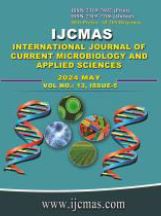


 National Academy of Agricultural Sciences (NAAS)
National Academy of Agricultural Sciences (NAAS)

|
PRINT ISSN : 2319-7692
Online ISSN : 2319-7706 Issues : 12 per year Publisher : Excellent Publishers Email : editorijcmas@gmail.com / submit@ijcmas.com Editor-in-chief: Dr.M.Prakash Index Copernicus ICV 2018: 95.39 NAAS RATING 2020: 5.38 |
Garlic is one of the major commercial crops which is used in many different ways worldwide. In southern Karnataka districts the crop is grown in Chamarajanagar, Mandya, Chithradurga, Tumakuru, Hassan, and Mysuru district. During survey it was noticed that, bulb rot disease has severely affected the garlic fields which is caused by F. proliferatum and an average of 52.22% percentage disease incidence (PDI) was recorded. However, district wise disease incidence varied with having the lowest PDI recorded in Hassan district with 36.08% PDI while the highest PDI of 60.26%, was recorded in Tumakuru district. The disease causing pathogen F. proliferatum isolated from infected garlic collected from garlic growing fields of Chamarajanagara. The pathogenicity of the isolated species on garlic was confirmed by artificial inoculations and reisolations of the pathogen from the diseased bulb. The isolated pathogen further confirmed by morphological and molecular characterization. The disease gain importance as F. proliferatum is known to produce a mycotoxin fumonisin which is toxic when the infected garlic is ingested. This is the first report from Southern Karnataka region, India.
Chretien P. L., Laurent S., Bornard I., Troulet C., El Maataoui M. and Leyronas, C. (2020). Unraveling the infection process of garlic by Fusarium proliferatum, the causal agent of root rot. Phytopathologia Mediterranea, 59(2): 285-293. https://doi.org/10.14601/Phyto-11103
Dugan F. M., Hellier B. C. and Lupien S. L. (2007). Pathogenic fungi in garlic seed cloves from the United States and China, and efficacy of fungicides against pathogens in garlic germplasm in Washington State. Journal of Phytopathology, 155(7-8): 437-445. https://doi.org/10.1111/j.1439-0434.2007.01255.x
Elshahawy I. E., Saied N. M. and Morsy A. A. (2017). Fusarium proliferatum, the main cause of clove rot during storage, reduces clove germination and causes wilt of established garlic plants. J Plant Pathology. 99(1): 85-93.
FAOSTAT (2022) Data. http://www.fao.org/faostat/en/#data.
Lalak-Kanczugowska J., Witaszak N., Waskiewicz A., Bocianowski J. and Stepien L. (2023). Plant Metabolites Affect Fusarium proliferatum Metabolism and In Vitro Fumonisin Biosynthesis. Int. J. Mol. Sci., 24(3002): 1-16. https://doi.org/10.3390/ijms24033002
Moharam Moustafa H. A., Eman S. Farrag and Mazhar D. A. Mohamed. (2013). Pathogenic fungi in garlic seed cloves and first report of Fusarium proliferatum causing cloves rot of stored bulbs in upper Egypt. Archives of Phytopathology and Plant Protection, 46 (17): 2096-2103. https://doi.org/10.1080/03235408.2013.785122
Mondani L., Chiusa G. and Battilani P. (2021). Fungi associated with garlic during the cropping season, with focus on Fusarium proliferatum and F. oxysporum. Plant health progress, 22(1): 37-46. https://doi.org/10.1094/PHP-06-20-0054-RS
Palmero Llamas D., Garcia C., Nosir W., Galvez Paton L., Cruz A., Wood Ward S., Gonzalez Jaen M. T. and Tello Marquina, J. (2012). Fusarium proliferatum isolated from garlic in Spain: Identification, toxigenic potential and pathogenicity on related Allium species. Phytopathol. Mediterr, 51: 207-18.
Stankovic S., Levic J., Petrovic T., Logrieco A. and Moretti A. (2007). Pathogenicity and mycotoxin production by Fusarium proliferatum isolated from onion and garlic in Serbia. Eur J plant pathol, 118(2): 165-172. https://doi.org/10.1007/s10658-007-9126-8
Wheeler, B.E.J. (1969) An Introduction to Plant Diseases. Wiley and Sons, London, 374 p. |
 |
 |
 |
 |